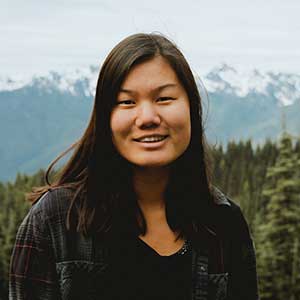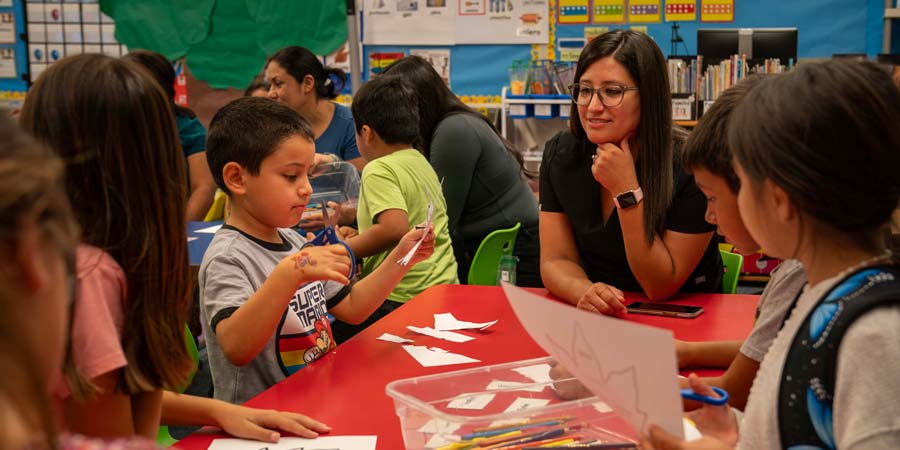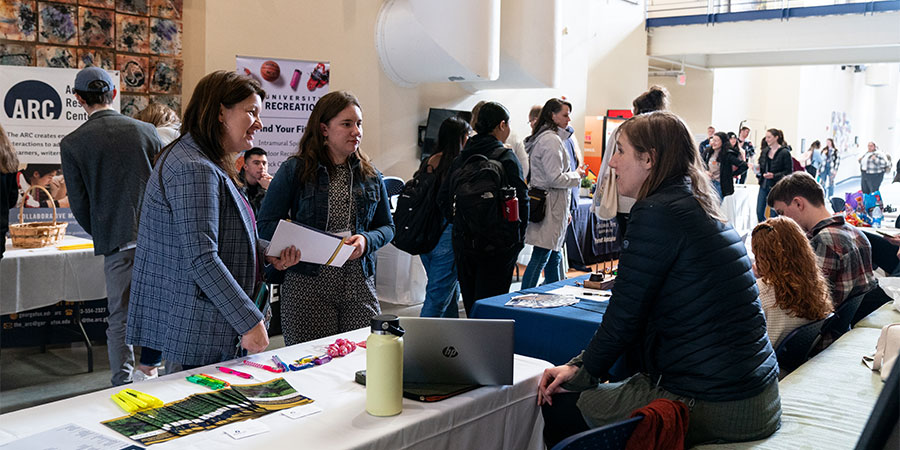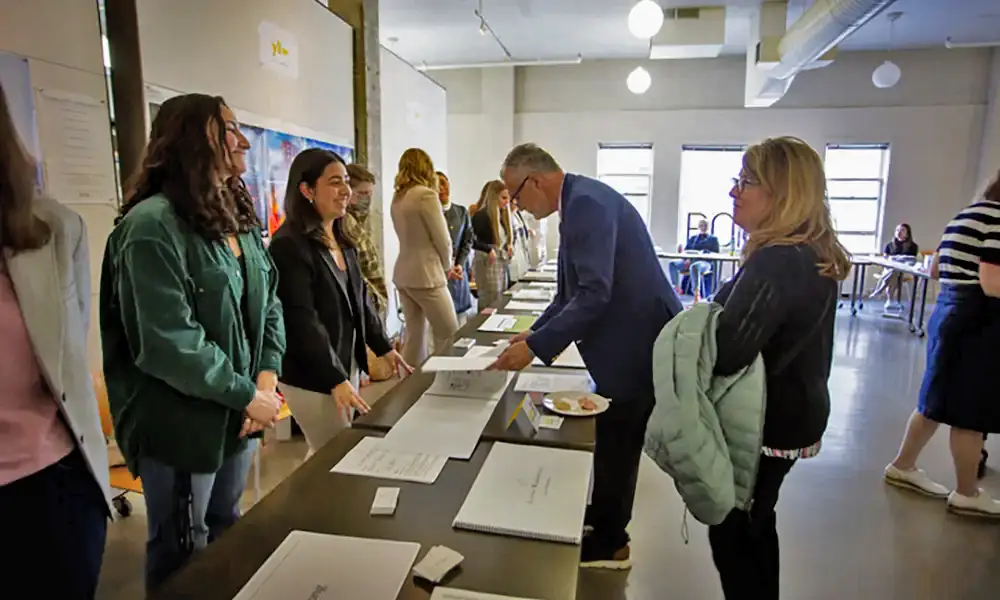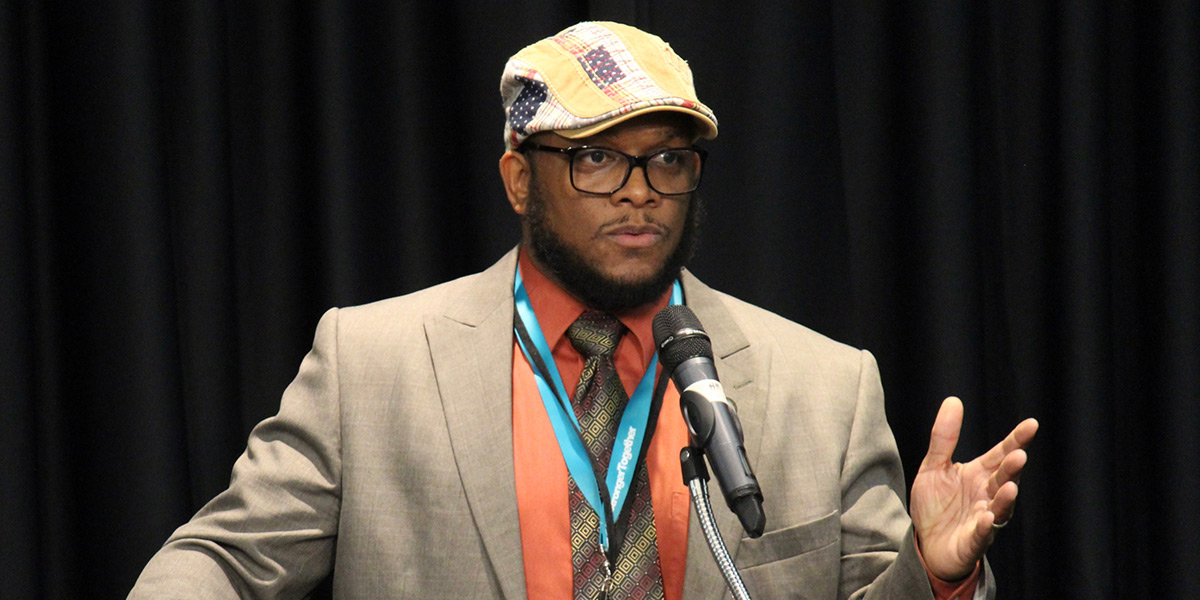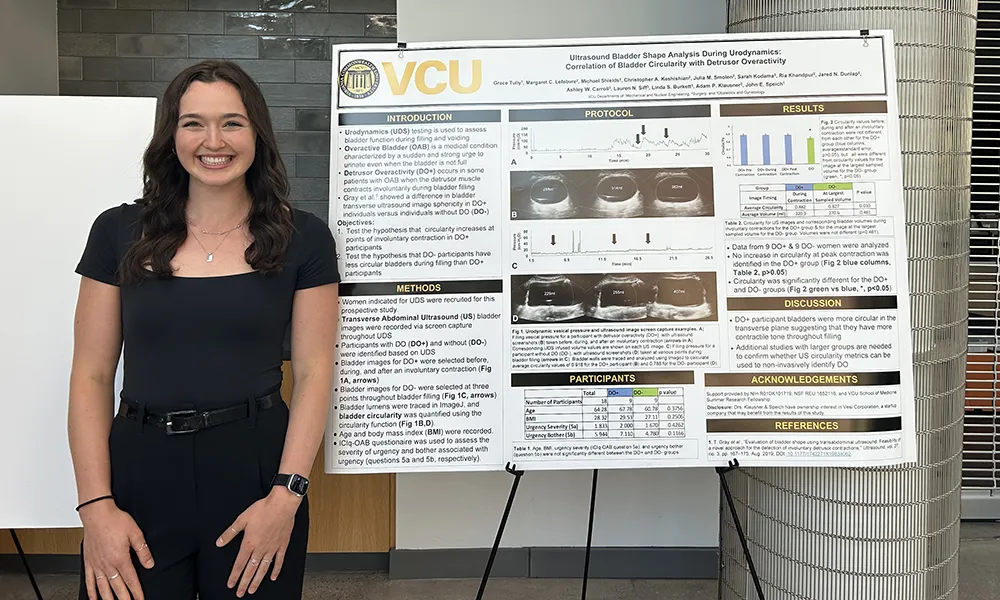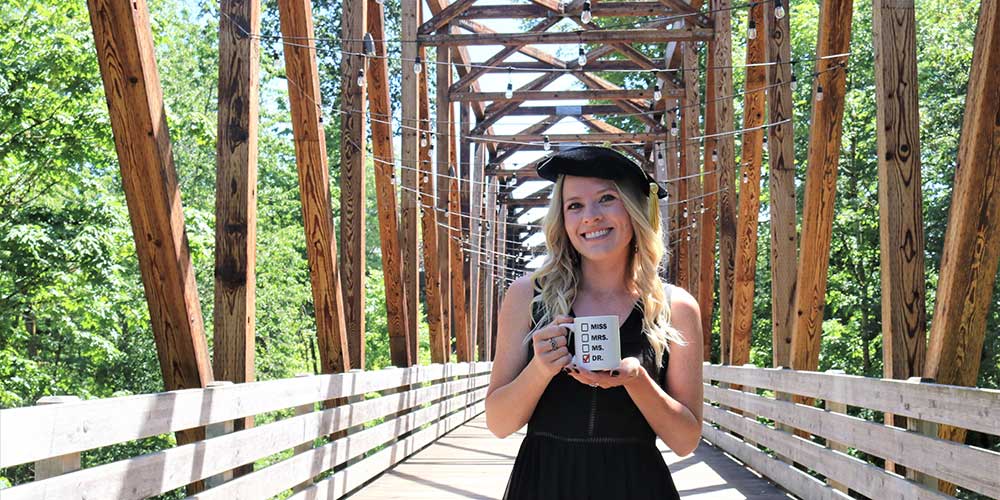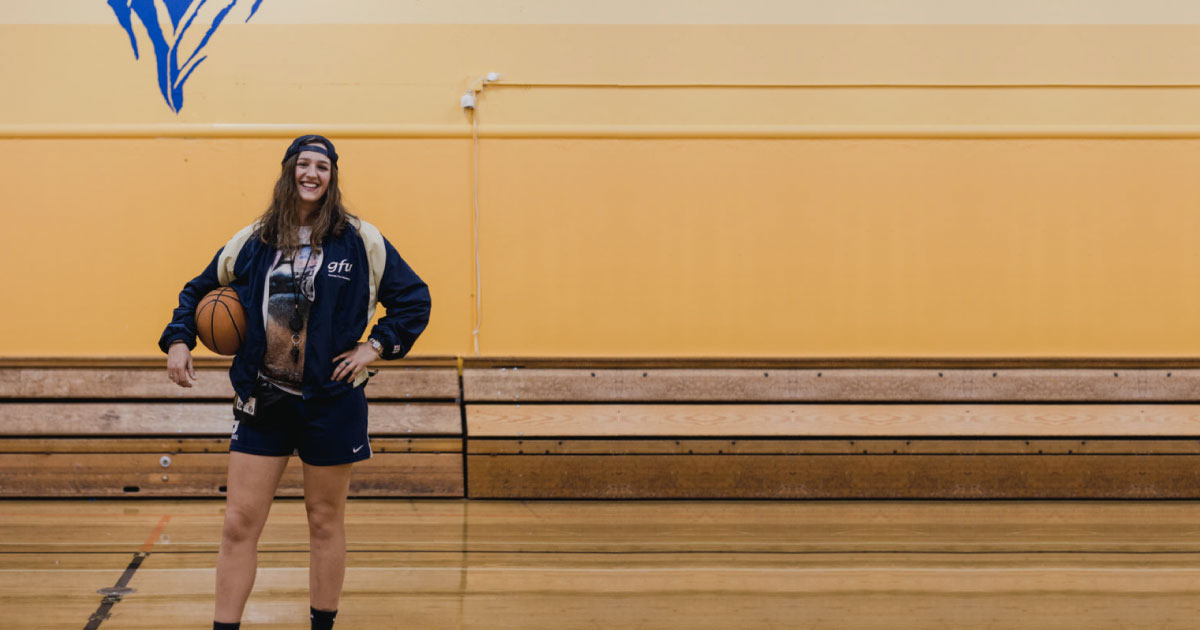
Alumna Mikaela Easterlin
by Hannah Dugan
It’s Friday afternoon, the last period of the day, and the gym at Harriet Tubman Middle School is nothing short of organized chaos. Basketballs hit the floor in a constant thunder as Shakira blasts from a large speaker. Some kids chat with their friends by the wall, others are locked in intense games of 1-on-1. Swirling at the center of it all is the school’s first and only physical education teacher, Mikaela Easterlin. It’d be easy to feel sorry for her, alone with 30 antsy seventh-graders with the weekend on their minds, if it weren’t so obvious she was having a blast.
This is Easterlin’s first time teaching, period. But watching her drift around the gym during class in her ’80s-esque-thrifted George Fox windbreaker, galactic sloth tee and backwards snapback, you wouldn’t guess it. She is both at home and in command.
“Yeah, Ms. E’s cool,” says one of her students. “She taught me how to do this.” He dribbles once, pulls up at the three-point line and lets one fly.
“That’s right,” Ms. E herself says as she walks past, stopping to give him a high five.
A Love of Athletics and Mentorship
Easterlin is an athlete through and through. A varsity player in basketball, lacrosse and soccer in high school, she played the former two as an undergraduate at George Fox University. When it came time to decide on a career path, two things were clear: her love of athletics and her love of mentorship.
Throughout high school and college, Easterlin had a penchant for taking younger kids under her wing and mentoring them. I would know; I was one of them.
For me, this looked like drives to practices with Taylor Swift blasting, coffee dates and a surprising amount of ridiculous singing and dancing in public. If you found it embarrassing you soon got tired of being embarrassed, or just forgot to be embarrassed altogether, and you just joined in. Which was, of course, her objective all along.
Easterlin’s mom recognized her daughter’s natural ability for leadership on and off the field. One day she suggested, “You should be a PE teacher because that’s the perfect combination of those two things.”
And that sealed the deal.
The Challenge of Racial Reconciliation in a Diverse Middle School
As Easterlin puts it, “Middle school is tough. I don’t know many people who had a good experience in middle school. I just really want to be there for them as well as teach them how to live a healthy life, enjoying sports and athletics.”
Five years later, with her master’s degree in hand, she was ready to do just that. But it was her calling to inner-city schools that led Easterlin to Harriet Tubman in particular. Harriet Tubman wasn’t a school when she applied for the PE teacher position there. She couldn’t visit or see a PE class in action beforehand. There was an interview with Natasha Butler, the principal.
“She was fantastic. We got along really well, and after that I really wanted the job,” Easterlin says.
When Harriet Tubman opened its doors for the first time this fall, Mikaela Easterlin was the school’s new PE teacher.
The inception of Harriet Tubman Middle School reads like a math problem: The student body is 50 percent black, 50 percent white. The students are taken from four Portland feeder schools that were K-8 and are now just K-5. Two of those feeder schools are from very high-income areas, and two are from very low-income areas. Each kid knows only a quarter of the school. Add the difficulties of middle school and mix. What do you get? “Lots of fights” is the answer, according to Easterlin.
“We have at least one fight every day,” she says. In fact, just a half-hour prior she had had to diffuse a potential fight in her class.
It’s no secret that Portland has a racist past; the black community has largely been pushed out by gentrification and a law forbidding realtors to sell houses to people of color. This was only 20 to 30 years ago.
“This school is like the last hurrah of bringing the black community back to Portland,” says Easterlin. “But because of that the whole community is watching us like a hawk. We’ve got to be careful and make sure we’re doing the best we can.”
It’s a tall order any way you look at it. Only about 30 percent of the faculty at Harriet Tubman is white. These kids “don’t want another white lady yelling at them,” as Easterlin puts it. Getting more black role models, especially male ones, is a huge priority. The community has stepped in to make this happen, from parents monitoring hallways to the involvement of the Maurice Lucas Foundation, which offers, among other support, two full-ride scholarships to any college, eligible to kids who stick with the program and maintain good academic standing.
On top of that, a lot of the kids come from very troubled pasts. They come with a boatload of triggers that many adults aren’t even conscious of. It didn’t take long before Easterlin started wondering how many of these triggers she was unconsciously playing into.
Easterlin grew up in a decidedly nondiverse southwest Portland neighborhood and attended a nearly all-white high school and college. Stepping into the halls of her new school was something akin to culture shock.
“There’s this whole environment and community that I don’t understand. I’m learning how my whiteness affects people around me, and that’s a huge thing that I’ve never had to deal with before,” she says.
She’s had to apologize to a number of middle schoolers this year. One time she heard a girl calling another the n-word. The student got defensive when she tried to correct her language.
“She got all up in my face and was talking back, saying how that’s my philosophy, and her philosophy is that it’s a positive thing and she can say that; it means they’re friends and family,” Easterlin recalls.
Easterlin then called the girl’s mom, prefacing the discussion by letting her know she was a white person, that she didn’t entirely understand this, but nevertheless this was what she was feeling.
“Yeah, we use that all the time at home, and I really don’t think that’s a problem,” said the mom. “But I will let her know that she needs to be aware of what she’s saying at school.”
That got Easterlin thinking. “OK,” she thought, “so this is something that I need to change my frame of mind about.” She consulted one of her black colleagues about the matter.
“It’s none of your business,” the colleague told her. “If they say that word it is none of your business.”
Building Relationships … and Trust
Easterlin knows that, in order to build the relationships that she wants, she has to build trust. To build trust, she has to bridge the gap of understanding between the cultures in her classroom.
“I’m still on that journey, and I think I’ll continue that journey my whole life. It’s really been eye-opening,” she says.
They always say the first year of teaching is the hardest. But it’s safe to say that Easterlin’s learning curve has been steeper on every front than anything she was expecting.
She made her lesson plans from scratch. For the first four weeks she had no equipment. She can’t even discipline her students with detention because there is no detention yet. She is completely new to them, and they are all new to each other.
And she’s had accusations from kids who have insinuated that she is racist. “It really sucks to hear that,” she says. “It’s making me think, ‘Am I treating kids differently?’”
While this thought is always in the back of her head, signs of the fruit of her labor have been cropping up of late. Students give her drawings, hugs, or come up to her to show her a new secret handshake. They follow instructions without her having to repeat them a million times.
And if she’s not seeing victories, she’s learned that often means it’s time to change her frame of mind. “There’s little victories that happen every day that sometimes I don’t realize are victories because they might not be up to my standards,” she says.
For instance, one of her students has Oppositional Defiant Disorder. Anything she asks for is met with a “no,” backtalk and cussing. After one such episode, Easterlin presented him with a form to fill out. It was an “express yourself” form.
“All right,” she told him. “Please just sit on the bleacher and fill this out. I just want you to take a minute and try and reflect.”
“I’m not upset, I don’t need to do this!” the student raged.
“Please, just write it down, fill it out.”
“Fine!”
He grabbed the sheet and wrote down “nothing” as the answer to everything. Easterlin was upset; he wasn’t taking it seriously. But then she talked to another teacher about it.
“She was like, ‘You know what Mikaela, in this case, nothing is something. The fact that he was writing that down gave him two minutes to calm down. It took him out of the situation,’” Easterlin says.
“True,” she thought. He wrote it down. He didn’t just chuck it on the ground. He wrote “nothing.”
“And that is a win. That’s a little tiny victory. So nothing is something,” she laughs.
In the small gym the bell rings and the seventh-graders flood out of the doors and into the weekend. A few turn to shout goodbye to Ms. E, and two boys hang around to shoot hoops while she cleans up.
This wouldn’t have happened a few weeks ago.
In a few years maybe she’ll be teaching the less-intensive high school PE. Maybe she’ll move more into coaching. But Easterlin’s goal right now, right here, is to build relationships with her students and earn their trust.
“I really wanna earn it,” she says. “That’s my goal. And having them come back next year, step into my gym and know what my expectations are . . .”
She smiles blissfully at the thought.
“I’m excited for that.”
